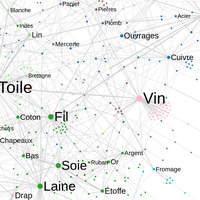Using networks to study 18th century French trade
- Track: Graph Processing devroom
- Room: H.1308 (Rolin)
- Day: Saturday
- Start: 13:10
- End: 13:50

France started to compile statistics about its trade in 1716. The "Bureau de la Balance du Commerce" (Balance of Trade's Office) centralized local reports of imports/exports by commodities produced by french tax regions. Many statistical manuscript volumes produced by this process have been preserved in French archives. This communication will relate how and why we used network technologies to create a research instrument based on the transcriptions of those archives in the TOFLIT18 research project. Our corpus composed of more than 500k yearly trade transactions of one commodity between a French local tax region or a foreign country between 1718 and 1838. We used a graph database to modelize it as a trade network where trade flows are edges between trade partners. We will explain why we had to design a classification system to reduce the heterogeneity of the commodity names and how such a system introduce the need for hyperedges. Our research instruments aiming at providing exploratory data analysis means to researchers, we will present the web application we've built on top of the neo4j database using JavaScript technologies (Decypher, Express, React, Baobab, SigmaJS). We will finally show how graph model was not only a convenient way to store and query our data but also a poweful visual object to explore trade geographical structures and trade products' specialization patterns.
By Paul Girard and Guillaume Plique. Sciences Po, médialab, Paris, France
Project funded by the French Agence Nationale de la Recherche (TOFLIT18)
Speakers
| Paul Girard |